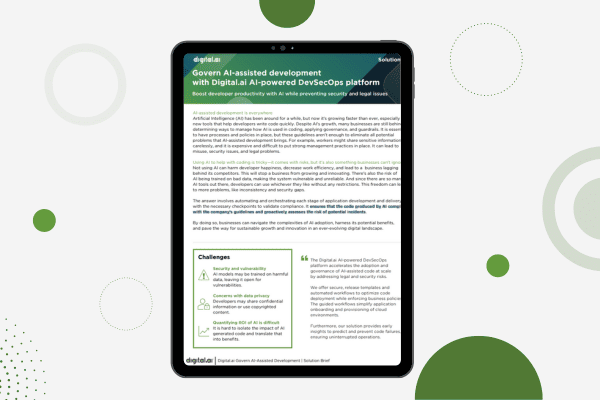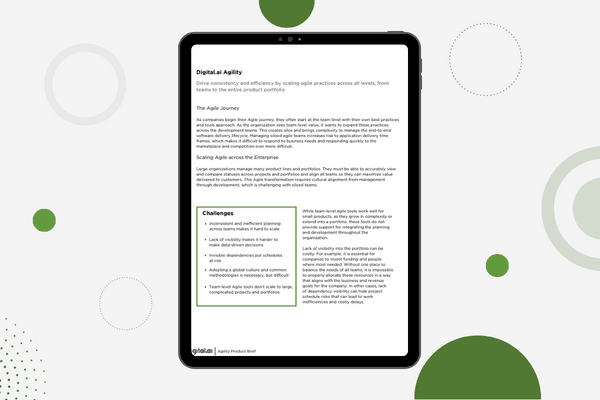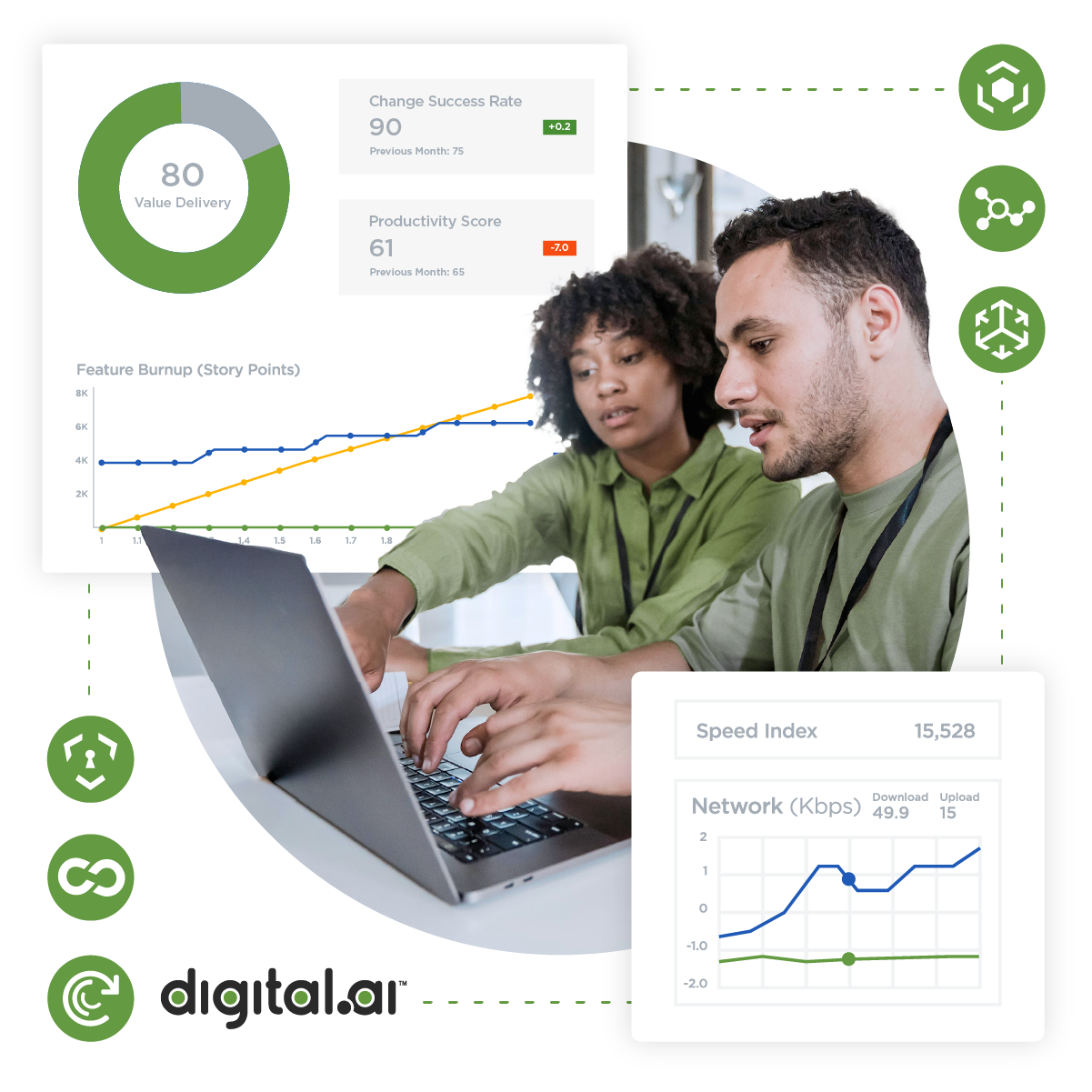What is Agile Project Management (APM)?
Learn the key components of Agile Project Management and grasp its principles, methodologies, and tools. Boost your team’s performance and adaptability.
Table of Contents
Agile Project Management (APM) is a dynamic approach to managing projects, especially in software development, that focuses on iterative progress, team collaboration, and customer satisfaction. Unlike traditional, linear project management methods, Agile offers flexibility, allowing teams to adapt quickly to changes, respond to customer feedback, and continuously improve their output.
Agile project management helps teams deliver value incrementally rather than waiting for a final product, enabling rapid prototyping, faster time to market, and enhanced customer satisfaction. With the right tools, Agile methodologies can be applied across industries to streamline processes and improve overall project efficiency. Learn how Digital.ai Agility empowers teams to bring agility to the enterprise level.
Core Principles
Agile Project Management builds its foundation upon several key principles emphasizing adaptability, incremental progress, and consistent communication. These principles help organizations create a culture that fosters rapid response to changes while maintaining a focus on value delivery.
Iterative Development
Agile project management uses iterative development to break down a project into small cycles, often called iterations or sprints. Each iteration involves a complete loop of planning, executing, and evaluating, enabling the development team to adjust based on feedback, learning, and shifting project goals. By delivering functional pieces of the project regularly, teams can provide more tangible progress, and stakeholders have a chance to review and contribute early in the project lifecycle.
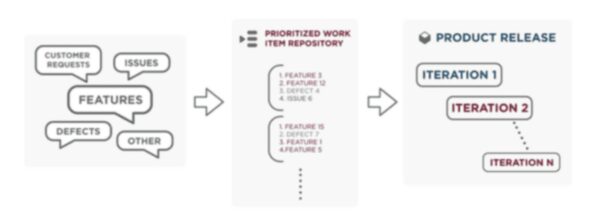
Incremental Delivery
Incremental delivery complements iterative development by allowing teams to deliver small, usable portions of the product over time. This principle provides a clear picture of progress and helps keep project stakeholders updated and engaged throughout the development process. Incremental delivery not only reduces risks but also makes the product usable sooner, enhancing customer satisfaction and allowing early benefits realization.
| Feature | Incremental Delivery | Big Bang Release |
|---|---|---|
| Risk Management | Lower risk, frequent testing | Higher risk, limited testing until final release |
| Customer Involvement | Ongoing feedback | Limited to post-release |
| Product Usability | Parts usable early | Usable only at the final stage |
Collaboration and Communication
Agile is built on the idea that collaboration among team members, stakeholders, and customers is crucial. Teams work together daily and open channels of communication to stay aligned on goals, expectations, and the project’s state. Tools such as daily stand-ups, sprint planning sessions, and retrospectives create an environment where everyone is empowered to voice ideas, concerns, and suggestions for improvement.
- Daily Stand-ups: Short meetings to discuss progress and challenges, and plan for the day.
- Sprint Planning: Setting goals and tasks for each iteration.
- Retrospectives: Analyzing what worked well and what could be improved.
How Digital.ai Agility Supports Core Principles
Digital.ai Agility supports these core principles by providing a unified platform for iterative planning, tracking incremental progress, and enabling effective collaboration among team members and stakeholders. Through tools like sprint retrospectives, automated backlog management, and integrated communication features, Digital.ai Agility enhances every aspect of the Agile process, ensuring adaptability and responsiveness to customer needs. Explore how Digital.ai enables effective Agile practices at Digital.ai Agility.
Agile Methodology vs. Traditional Project Management
Agile methodologies differ significantly from traditional project management methods, particularly Waterfall. While traditional methods rely on rigid, linear sequences of tasks, Agile promotes adaptive and responsive approaches that allow teams to handle evolving project requirements more effectively.
Agile vs. Waterfall
Flexibility and Adaptability
The Waterfall method is known for its structured, sequential approach, where each phase must be completed before moving on to the next. This rigidity often makes it challenging to accommodate changes once the project is underway. In contrast, Agile’s flexibility allows teams to make real-time adjustments, prioritize customer feedback, and adapt to evolving requirements, which is crucial in today’s fast-paced environments.
Hypothetical Scenario: Comparing Non-Agile and Agile Outcomes
Imagine two companies, Company A and Company B, both aiming to develop a new mobile application within six months.
- Company A adopts a traditional Waterfall project management approach. They spend the first two months gathering all requirements, planning the full project in detail, and designing every aspect of the app before moving on to development. Once development starts, the team realizes halfway through that customer preferences have shifted, and the market now demands new features. However, because Company A has already locked in requirements and design, changing course is only feasible with a significant delay and rework. As a result, the project moves forward with outdated features, and when it is finally released, customers are dissatisfied with the product’s relevance to their needs. Company A must then initiate a costly update cycle post-launch to catch up with market demands, which extends the timeline and adds unplanned expenses.
- Company B, on the other hand, uses an Agile approach. They start by defining an initial scope but intentionally keep room for adaptability. The project is broken down into bi-weekly sprints, with each sprint focusing on developing a functional component of the mobile app. Throughout the development, Company B gathers continuous feedback from a group of early testers and stakeholders. By the third month, the team receives feedback about evolving user preferences, and they pivot to prioritize those features for the next sprint. As a result, when Company B launches the app after six months, it contains the most current and desired features. Customer satisfaction is high because the product has been continuously adjusted to meet users’ expectations. Additionally, the early releases allow Company B to identify and fix issues much earlier, reducing rework and making the overall project more efficient.
In this scenario, Company A struggles with rigid planning and late-stage rework, while Company B successfully adapts to market needs, releases a relevant product, and delivers customer satisfaction. This difference highlights the flexibility and adaptability that Agile methodologies offer compared to Waterfall.
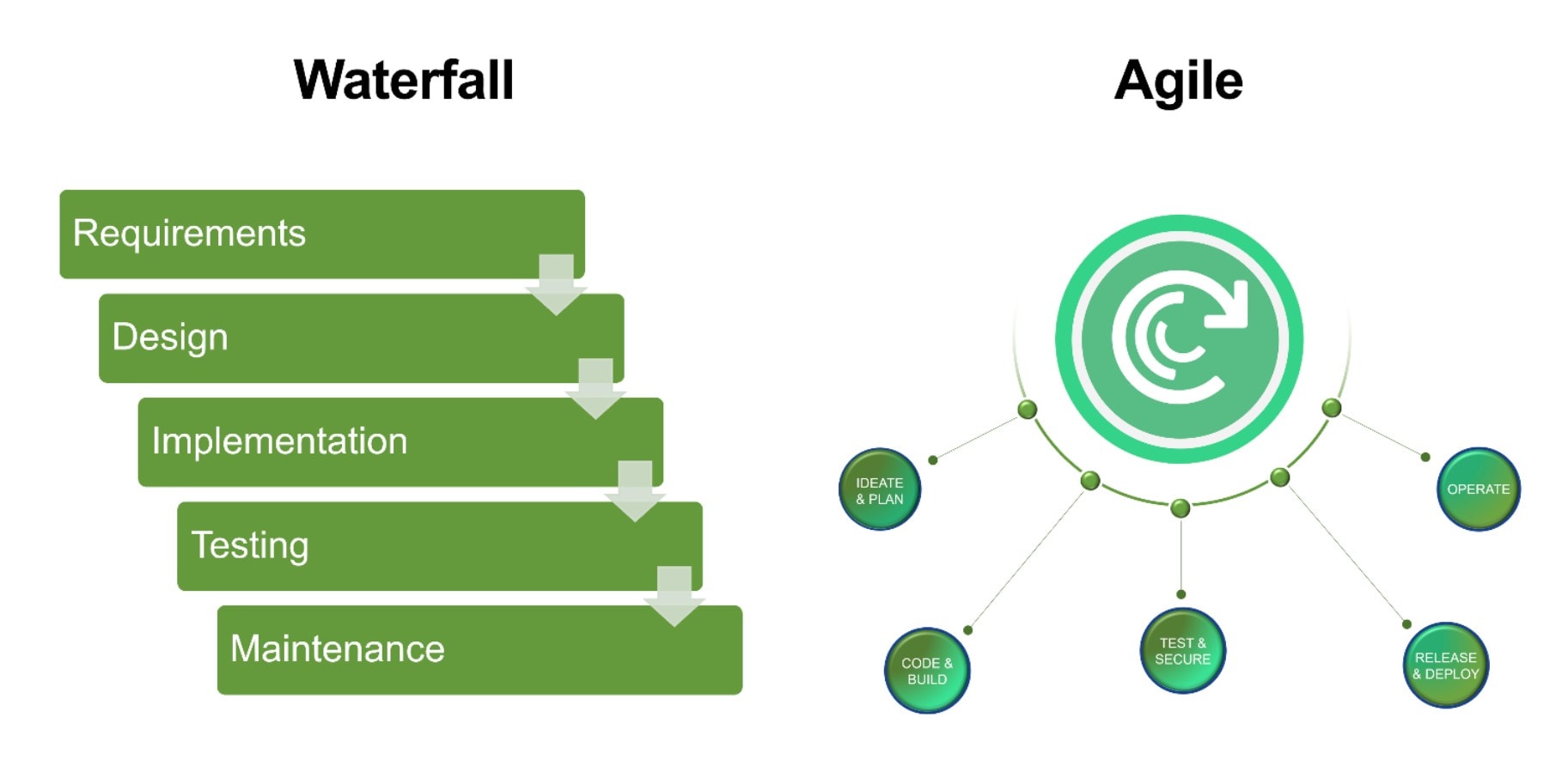
Scope and Planning
Traditional project management is characterized by fixed scopes and detailed upfront planning, which can lead to issues when project requirements evolve. Agile emphasizes dynamic scope management and ongoing planning, allowing project managers to adapt priorities based on the latest information, thus reducing the risk of delivering an outdated or irrelevant product.
| Attribute | Agile Planning | Waterfall Planning |
|---|---|---|
| Scope Flexibility | Dynamic and adaptable, a scope can evolve based on changing requirements | Fixed scope defined at the beginning, rarely changes throughout the project |
| Planning Approach | Incremental, iterative planning throughout the project | Extensive, detailed planning is conducted upfront before any development starts |
| Customer Involvement | Continuous customer feedback and involvement at every iteration | Limited customer involvement, typically only at the beginning and end phases |
| Risk Management | Risks are identified and managed incrementally, adjustments can be made mid-project | Risks must be anticipated and planned for early, with limited ability to adjust once the project is underway |
| Adaptability to Change | High adaptability; teams can incorporate new requirements or changes during each sprint | Low adaptability; changes are costly and difficult to implement once phases are completed |
| Documentation | Emphasis on “just enough” documentation to support development | Extensive documentation is typically required at each phase, often slowing down the process |
| Time and Cost Estimates | Estimates are continuously updated as the project progresses | Initial time and cost estimates remain fixed, leading to challenges if conditions change |
Benefits of Agile
Faster Time to Market
One of the major advantages of Agile is its ability to reduce time to market. By focusing on delivering small but functional increments, Agile teams can release product features quickly and continuously, allowing customers to benefit from them earlier and providing an edge in competitive markets.
Improved Customer Satisfaction
Agile encourages frequent customer interaction, enabling teams to gather ongoing feedback and adjust deliverables accordingly. This results in higher customer satisfaction, as products are developed in alignment with customer needs, and issues are addressed promptly.
Challenges of Agile
Team Dynamics
Agile’s success heavily depends on team collaboration and self-management. Projects may encounter significant obstacles without effective communication or if team members struggle to adapt to a collaborative culture. Teams must foster an environment of trust and open dialogue to fully realize Agile‘s potential.
Scaling Agile
While Agile works well for small teams, scaling Agile to larger organizations presents unique challenges. Frameworks such as Scaled Agile Framework (SAFe) and Large Scale Scrum (LeSS) help address these challenges, but scaling often requires careful coordination, clear roles, and a disciplined approach to maintaining Agile principles across teams.
How Digital.ai Agility Supports Agile Methodology
Digital.ai Agility helps organizations transition to Agile by providing adaptive planning tools that enable flexibility while maintaining alignment across teams of teams. With features designed to manage scope, track ongoing changes, and support strategic alignment, Digital.ai ensures that teams can effectively respond to new information and deliver value faster. Additionally, Digital.ai’s platform is well-suited for scaling Agile practices, providing visibility across multiple teams, and ensuring consistent workflows at an enterprise scale.
Agile Tools and Technologies
A variety of tools and technologies are integral to effective Agile project management. These tools help streamline processes, automate repetitive tasks, and maintain communication across geographically dispersed teams.
Project Management Software
Jira
Jira is a commonly used project management tool in Agile. It provides team-level support to manage tasks, track progress, and organize sprints. Jira’s features help streamline work management and ensure transparency in team activities.
Trello
Trello provides a visual approach to managing tasks using Kanban boards. It allows teams to quickly understand what needs to be done, by whom, and the current status of tasks, fostering a shared understanding among all team members.
Communication Tools
Slack
Slack is widely used for team communication, offering channels where team members can discuss specific topics and ensure timely information flow. Slack supports both direct messaging and group conversations, promoting transparency and quick decision-making in Agile settings. It also integrates with many other Agile tools, enhancing workflow automation.
Teams
Microsoft Teams integrates video calls, chat, and other collaborative tools, making it an effective communication platform for Agile teams. Teams provide a virtual meeting space, file sharing, and app integration, enabling seamless collaboration among remote or dispersed team members.
Continuous Integration and Deployment
Jenkins
Jenkins is a popular open-source tool for continuous integration and continuous deployment (CI/CD), helping teams automate the building, testing, and deployment of code. It ensures that new code changes do not introduce errors into the project, enabling development teams to maintain quality and reduce delays.
GitLab CI
GitLab CI offers powerful features to automate the software development lifecycle, including continuous integration, delivery, and deployment. It helps teams establish an efficient pipeline for merging and deploying code, ensuring that each increment of work is reliable and ready for release.
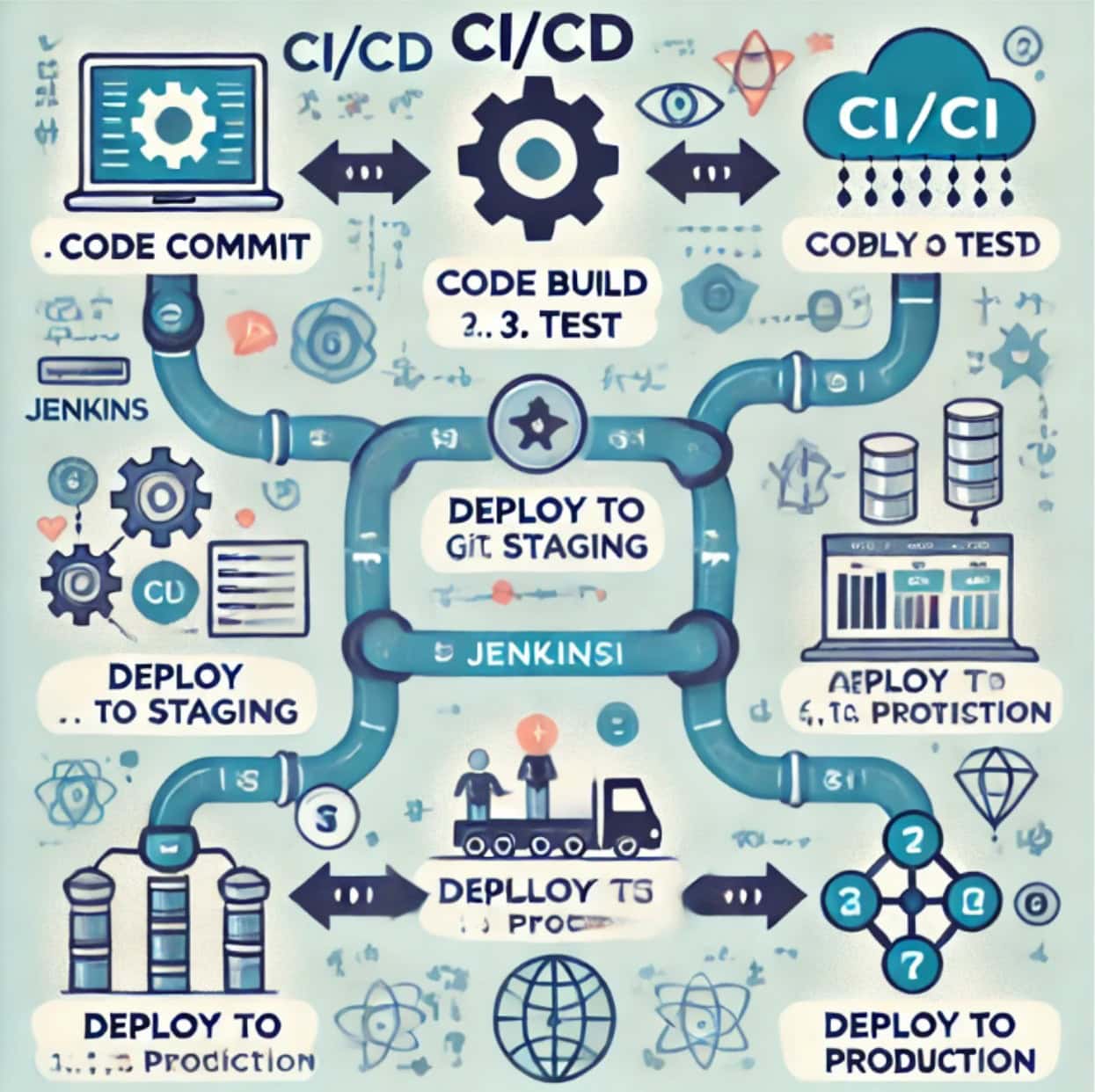
How Digital.ai Agility Supports Agile Tools and Technologies
Digital.ai Agility integrates seamlessly with leading Agile tools like Jira, Trello, Slack, and Jenkins, providing not just teams but teams of teams across the enterprise with a unified platform that enhances collaboration, automates key workflows, and improves visibility into project progress. By connecting with these popular tools, Digital.ai enables teams to leverage their existing setups while gaining access to powerful analytics and insights to optimize performance. Learn more about Digital.ai Integrations.
Implementing Agile in Organizations
Implementing Agile across an organization involves several steps, from initial training and pilot projects to scaling practices and avoiding common pitfalls.
Steps to Adopt Agile
| Step | Description |
|---|---|
| 1. Assess Readiness | Evaluate the current state of the organization’s culture, processes, and team readiness for Agile. |
| 2. Agile Training | Provide training and education to all stakeholders, including team members, managers, and leaders. |
| 3. Engage Agile Coaches | Hire or appoint Agile coaches to help guide the transition, provide expertise, and bridge knowledge gaps. |
| 4. Pilot Projects | Start with a pilot project to test Agile methods on a small scale. Identify challenges and successes. |
| 5. Select Agile Tools | Choose appropriate Agile tools (e.g., Jira, Trello, Slack) to support project management and collaboration. |
| 6. Set Up Agile Teams | Form cross-functional Agile teams with all the necessary skills to deliver an increment of value. |
| 7. Establish Framework | Select the right Agile framework (e.g., Scrum, Kanban) that aligns with the organization’s needs. |
| 8. Begin Iterative Work | Start work in iterations or sprints, focusing on regularly delivering small increments of value. |
| 9. Conduct Retrospectives | Hold regular retrospectives to review progress, identify improvements, and apply learnings to future iterations. |
| 10. Scale Agile | Once pilot projects are successful, scale Agile practices to additional teams and larger projects. |
Training and Education
The first step of an Agile implementation is ensuring that all team members understand Agile principles and how they can contribute to Agile processes. Training workshops, webinars, and hands-on learning sessions are effective ways to build this knowledge. Introducing Agile coaches can also help bridge knowledge gaps and provide real-time guidance for organizations new to Agile.
Pilot Projects
Adopting Agile often starts with a pilot project (Step 4), where a small team or department tries out Agile methodologies on a manageable scale. This approach helps identify challenges and success factors before expanding Agile practices throughout the organization. Pilot projects are an important way to demonstrate value and encourage broader adoption.
Scaling Agile Across Teams
There are many popular versions and offshoots of Agile, as well as methods that predated the Agile Manifesto but share its values. These include Scrum, Lean, Kanban, Extreme Programming (XP), Feature-Driven Development (FDD), Dynamic Systems Development Method (DSDM), and Crystal.
SAFe (Scaled Agile Framework)
SAFe (Scaled Agile Framework) provides a structured way to scale Agile practices across an organization, ensuring alignment across multiple teams while maintaining Agile values. It combines principles from Lean, Agile, and product development, allowing large organizations to adopt Agile while ensuring enterprise-wide alignment.
LeSS (Large Scale Scrum)
LeSS (Large Scale Scrum) is another approach to scaling Scrum across large teams, promoting coordination and shared understanding. LeSS emphasizes simplicity, keeping as much of the original Scrum framework intact as possible, while applying it to large-scale product development.
Common Pitfalls and How to Avoid Them
The Agile philosophy, developed to foster rapid responses to change, is now at a pivotal juncture, urged to evolve again and meet new, more complex challenges as the digital and cultural environments shift beneath our feet.
The 17th State of Agile Report gave us a good indicator of Agile’s current standing across many different-sized organizations and industries. Read the follow-up blog, “Hardly, strictly, agile,” where we asked how Agile can both withstand more modern changes and utilize them to propel organizations to new heights of innovation and success.
Below are some traditional, evergreened challenges enterprises often struggle with in scaling agile.
Resistance to Change
Resistance from team members or management can significantly hinder Agile adoption. This resistance often stems from fear of the unknown or concern over the shift from hierarchical processes to a more flexible structure. It is crucial to communicate the benefits of Agile clearly and involve stakeholders throughout the transition process to ensure buy-in and minimize resistance.
Inadequate Training and Support
Without adequate training and ongoing support, teams may struggle to apply Agile principles effectively. Providing continuous education, mentorship, and addressing concerns in a timely manner is key to overcoming this challenge.
How Digital.ai Agility Supports Agile Implementation
Digital.ai Agility aids in the implementation of Agile by offering a comprehensive suite of tools to adopt a methodology, such as SAFe, to train teams, manage pilot projects, and scale Agile across enterprises. By providing insights into team performance, facilitating strategic planning, and ensuring ongoing support, Digital.ai helps mitigate common pitfalls such as resistance to change and lack of adequate support, ensuring a smoother transition to Agile practices.
Measuring Success in Agile Projects
Measuring success in Agile projects is crucial for understanding team performance and the value delivered to customers. Agile uses specific metrics to track progress, identify areas for improvement, and maintain a cycle of continuous enhancement.
Key Performance Indicators (KPIs)
Velocity
Velocity measures the amount of work a development team completes in a sprint. By analyzing velocity, teams can predict future performance, estimate timelines more accurately, and adjust work commitments to match their capacity. Velocity is often expressed in terms of story points or hours, providing an objective view of productivity.
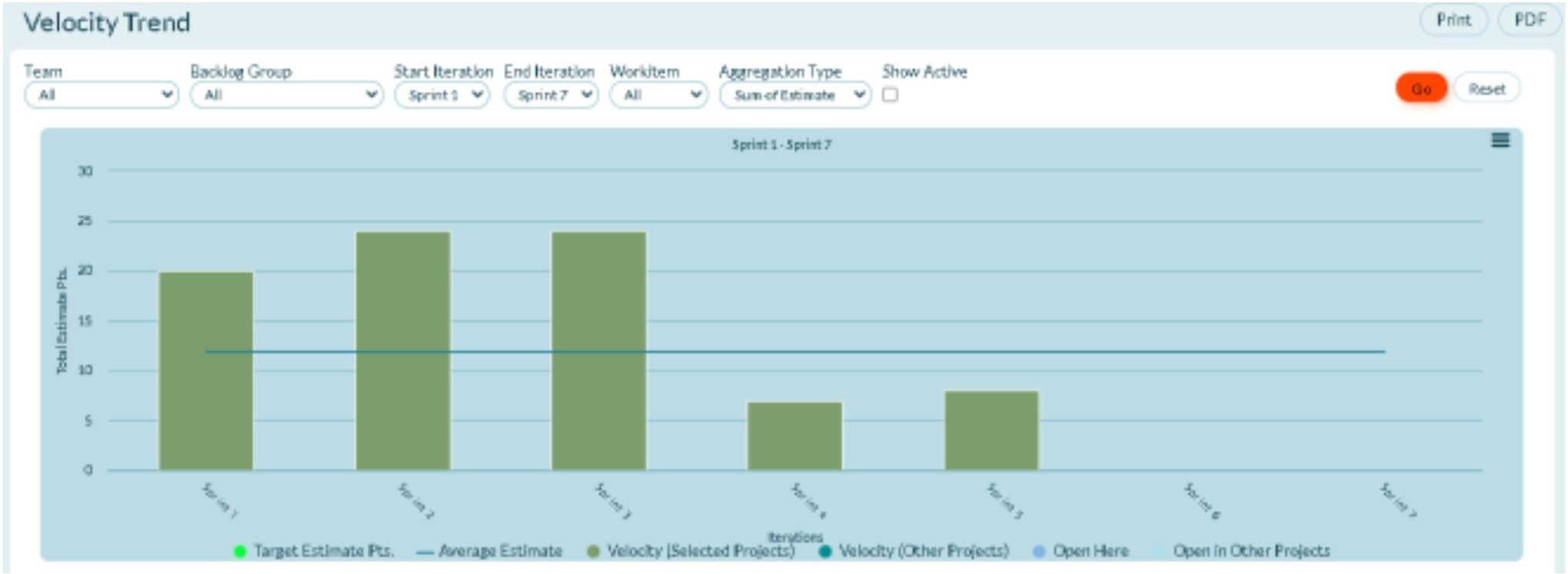
Burndown Charts
Burndown charts are visual tools that track work completion over time. They help teams understand if they are on track to complete the planned work within the sprint duration. Burndown charts also provide early warnings for potential delays, allowing teams to take corrective actions quickly. Tracking and analyzing burndown data can also offer insights into whether tasks are underestimated or if there are process inefficiencies.
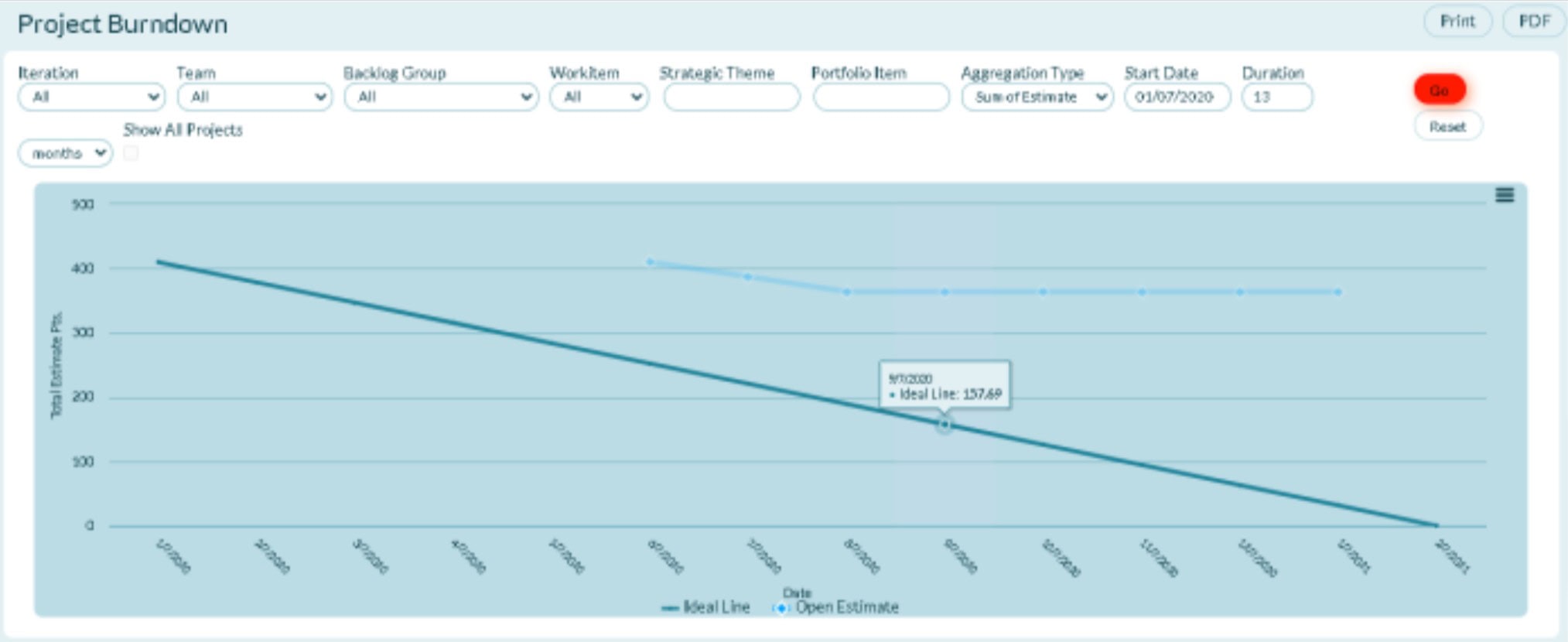
Continuous Improvement
Retrospectives
Retrospectives are meetings held at the end of each iteration to discuss what went well, what didn’t, and what can be improved. This focus on reflection and learning helps Agile teams become more efficient over time by eliminating waste and enhancing processes. A successful retrospective involves gathering feedback from all team members and deriving actionable steps for improvement.
| Element | Description |
|---|---|
| 1. Set the Stage | Create a comfortable environment. Start with an icebreaker to help team members feel open to sharing. |
| 2. Gather Data | Collect information about the iteration—what went well, what didn’t, and what was unexpected. Use techniques like affinity mapping or sticky notes. |
| 3. Generate Insights | Analyze the gathered data to identify patterns, root causes, and opportunities for improvement. Encourage discussions to dig deeper into key issues. |
| 4. Decide on Actions | Identify concrete action items the team can take to improve future iterations. Focus on achievable improvements and assign responsibilities. |
| 5. Close the Retrospective | Summarize the outcomes, appreciate team members for their contributions, and conclude with a positive note to foster team spirit. |
| 6. Follow Up on Actions | Review the progress on action items in the next retrospective to ensure accountability and continuous improvement. |
Feedback Loops
Feedback loops are integral to Agile, providing timely input from stakeholders, customers, and end-users. By regularly incorporating this feedback, Agile teams can align their work more closely with customer expectations and ensure continuous product improvements. Feedback loops also help adapt the product to meet market changes effectively and address user issues promptly.
How Digital.ai Agility Supports Measuring Success
Digital.ai Agility provides comprehensive tools for tracking essential Agile metrics such as velocity, burndown charts, and more. These metrics help teams gauge productivity, understand capacity, and align their delivery with strategic goals. Digital.ai also supports continuous improvement practices with built-in retrospective and feedback tools, helping teams foster a culture of ongoing learning and adaptation. Find out more about Agile Metrics and Analytics.
Summary
Agile Project Management has redefined how teams deliver value, focusing on adaptability, collaboration, and continuous customer feedback. By breaking projects into manageable iterations, embracing incremental delivery, and emphasizing strong communication, Agile empowers organizations to respond swiftly to change, enhance customer satisfaction, and foster a culture of continuous improvement.
Transitioning to Agile offers significant advantages over traditional project management approaches, such as Waterfall. From increased flexibility in scope management to faster delivery of usable increments of value, Agile methodologies have become essential for enterprises looking to stay competitive in rapidly evolving industries.
To successfully implement Agile, organizations need the right training, tools, and frameworks. Choosing an approach that scales effectively, embracing retrospectives, and incorporating powerful metrics are crucial to reaping the full benefits of Agile practices.
If you’re ready to take your organization to the next level, consider how Digital.ai Agility can help you bring agility to the enterprise. Digital.ai provides comprehensive tools to implement Agile, track performance, and ensure alignment across teams—helping you achieve outcome-based delivery and enterprise-wide agility.



